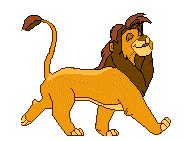
HISTORY AND CHARACTERISTICS
In November, 1955 the AKC admitted the Rhodesian Ridgeback to its Stud Book as the 112th breed. This breed is listed in the Hound Group. This breed has increased in recognition throughout the United States. The Ridgeback has excellent sight and an excellent nose. They are quiet, of a gentle temperment and rarely barks for no reason. They love lazing around in the hot summer sun or in a sleeping bag in the winter. A Ridgeback can be instantly alert if a stranger should appear or if he is in pursuit of prey. He gives that impression of a big, lazy lap dog, slow-moving animal (walks just like a lion). They are an excellent presence as a watchdog. They are not only developed to hunt, but also as an excellent family protector, his/her very affectionate disposition makes him/her an extremely trustworthy companion for children of all ages.
When European Boer settlers arrived in South Africa in the sixteenth and seventeenth centuries, they brought with them such breeds as the Mastiff, Great Dane, Bloodhound, Pointer, Staghound, and Greyhound, among others. These settlers needed a dog that could withstand both hot and cold temperatures, limited water, and rough bush, while performing the duties of guard dog and hunting dog. By breeding their Eurpoean dogs with native Hottentot tribal hunting dogs (which were distinguished by a ridge of hair growing in the opposite direction along the top of their back) they produced just such a dog. These dogs hunted by both sight and scent and were devoted protectors of the entire family. In the 1870s, several of these dogs were taken to Rhodesia to hunt lions, chasing and harassing the lion until the hunter could shoot it. The dogs were so successful that the "Lion Dogs" became popular, their distictive ridge becoming a trademark of quality. By the 1920s, so many different types of ridged Lion Dogs existed in Rhodesia that a meeting was held to eludicate the most desirable points of the breed, which became the basis for the current standard. Dogs meeting the standard criteria were known as Rhodesian Ridgebacks (the dog's former designation as Lion Dogs was deemed to sound too savage). The breed was introduced into England in the 1930s and to America soon after. In both cases, it gained recognition in the 1950s and quickly attracted admirers. In the 1980s, the breed recieved recognition as a sighthound and became eligible to compete in sighthound field trials. Today it is among the more popular hounds, undoubtedly because it combines the abilities of hunter, protector, and companion in a sleek handsome body.In November, 1955 the AKC admitted the Rhodesian Ridgeback to its Stud Book as the 112th breed. This breed is listed in the Hound Group. This breed has increased in recognition throughout the United States. The Ridgeback has excellent sight and an excellent nose. They are quiet, of a gentle temperment and rarely barks for no reason. They love lazing around in the hot summer sun or in a sleeping bag in the winter. A Ridgeback can be instantly alert if a stranger should appear or if he is in pursuit of prey. He gives that impression of a big, lazy lap dog, slow-moving animal (walks just like a lion). They are an excellent presence as a watchdog. They are not only developed to hunt, but also as an excellent family protector, his/her very affectionate disposition makes him/her an extremely trustworthy companion for children of all ages.
TEMPERMENT
The Rhodesian Ridgeback is the Hound Group's answer to a somewhat protectiv dog. Not only is it a keen and versatile hunter, but is a loyal guardian. It is good with children, especially protective of those in its family, but it is sometimes overly boisterous in play for small children. Small children have been known to have been wacked by the strong wagging tail of the Rhodesian Ridgeback. Only on accident :) It can be a strong-willed and powerful: Some can be domineering as well. Usually the females. The females are known for being the leaders. Lion Hounds STRONGLY recommends "PETSMART 8 WEEK TRAINING COURSE" A trained Ridgeback is a beautiful compliment to any family. They are also VERY VERY INTELLIGENT. Don't be fooled. They require discipline as with any toddler. And they remember like elephants. A good stern "NO" they will remember if they are protraying unacceptable behavior. They are very easily trained and they love to learn on a continuing basis. They are curious and the most "human like" breed. A thinking breed as well, as they are NOT over-reactors. They think before they do things. The Rhodesian Ridgeback is usually reserved with strangers and can be very protective toward strange dogs and animals. Typically when raised with other animals are very adaptable and are always accepting of other animals. However, I would never recommend a Rhodesian Ridgeback as an adult to enter a new home and having never being introduced to a cat or kitten in their lives. Usually with their hunting ability as intact and developed as an adult, they will most likely accept the cat or kitten with no problem or the cat or kitten with become the prey of the dog.
GROOMING:
Because of thier short coat, Ridgebacks shed very little. They very rarely ever need bathing. They are very clean animals. Once a week brushing, occasional baths, ear cleaning nad nail trimming are all that is needed to keep them well groomed, clean and odor free. Typically, they their fur is dirt resistant and they have no odor. FORM AND FUNCTION: Rhodesian Ridgebacks are slightly longer than tall, the Ridgeback combines features of speed, power, and endurance. The Rhodesian Ridgeback must have an athletic build to enable it to catch up to a lion and then harass it without being hurt. Because the lion is not the only quarry of the Ridgeback, the dog must also be strong enough to bring down other large game. Its stride is efficient and long. The short glossy coat is adapted for working in hot climates. A distictive feature is the clearly defined ridge, which should start with two identical whorls just behind the shoulders and taper to a point between the hipbones. HEALTH: Life Span: 10-13years Some RR's have been known to live 18 years. UPKEEP: The Ridgeback loves to run, and it needs daily mental and physical exercise to keep it from becoming frustrated. It can be a good jogging or hiking companion. The Ridgeback can live outdoors in temperate or warm climates, but they are usually much happier sleeping indoors taking up the couch and the bed :) as least I know mine are :) They like to divide their time between the house and yard during the day
[ Your Text Here ]


RIDGEBACK HISTORY